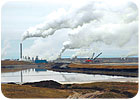
Fort McMurray oil sand mines and refining plants
in the background.
Photo by William E. Rogers
Photo by William E. Rogers
I recently had the opportunity to visit Ft. McMurray, which is located about 300 miles north of Edmonton, in Northern Alberta, Canada. It’s not the northern most point on the road but you can see it from there. The area is a phenomenon because it contains the largest known cash of petroleum in the world. You didn’t know that? Well, neither did I until recently. The amount of oil sand in Alberta is enough-at their current rate of consumption-to provide Canada all of the petroleum it would need for the next 475 years. It’s enough oil to meet the needs of the entire planet for the next 15 years.
As we entered the bustling town of Ft. McMurray, my guide Richard Wassill, business manager of the Plasterers and Cement Masons Union, said, “Can you smell the money yet?” The town is a modern day equivalent to the 49ers Gold Rush, filled with men and women in search of high wages and steady work. The motels were booked to capacity, a line of HD pick-up trucks stretched for miles coming out of the plants during a shift change and you could indeed smell the money in the air.
The oil that brings all of these people to the area is not found in deep underground pools. Nor can one extract it by simply setting up a derrick and drilling down and pumping it out into barrels or piping it to a refinery. No, you’ve got to work a lot harder than that if you want to harvest this massive reserve of “black gold” or as the Beverly Hillbillies also called it, “Texas Tea.”
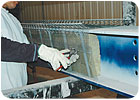
Tying on lath
Photo by William E. Rogers
Photo by William E. Rogers
Fat Alberta
The petroleum in northern Alberta is found in the top layers of soil down to about 400 meters below the surface. Early natives used the material they discovered in the ground to seal and repair their canoes. In the early 1900’s, it was mined and used unrefined for paving roads, much like modern asphalt. By the ’30s, they found a way to separate the sand and refine it as a roofing product and during World War II the government threw in enough resources to begin high tech refinement as fuel oil and gasoline. This is an expensive process and the science and technology of the ’40s was not yet developed to accommodate profitable production, and after the war demand died down, inexpensive oil from the Middle East, South America and elsewhere filled consumers demand for fuel at reasonable prices.By the mid-’60s, the processing of turning oil sand into synthetic crude began in earnest. With North America’s political concerns over the security of imported oil, Canada’s oil sands are predicted to become the primary source of oil for both Canada and the United States in coming years.
So how do they separate the oil from the sand? Simple, use hot water and lots of it.
A thick tar-like substance called bitumen has been left by nature intertwined with fine silica sand. This “oil sand” is harvested in large open strip mines. The raw oil sand is shipped to a nearby processing plant, where it is mixed with hot water until the bitumen is softened and can be separated from the sand. The bitumen is then heated to a high temperature until its molecular structure is broken down, allowing it to be separated into three components that can then be blended into a high-grade synthetic crude oil. The sand, a byproduct of the process, is returned to the mines and the area is planted over with trees and shrubs, ensuring the integrity of the land and the survival of the ecosystem.
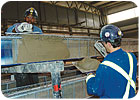
Plasterers applying fireproofing with hawk and trowel
Photo by William E. Rogers
Photo by William E. Rogers
The house of sand and oil
So what does all this sticky stuff have to do with plaster? The enormous processing plants that are used to separate the oil and the sand, and the plants used to process the bitumen into synthetic crude are erected of structural steel. These structures house miles of pipes, boilers, and vessels filled with highly flammable products. And just as in commercial construction, fireproofing is used to insulate the steel from heat, protecting the production facilities from structural failure in the event of a fire.“Because these structures are open to the elements, and because the temperatures in Northern Alberta can range from 100 degrees F in the summer to -40 degrees F in the winter, some special procedures are involved to ensure the integrity of the fireproofing,” says Jeff Granberg, president of Park Derochie Coatings Ltd., the largest applicator of industrial fireproofing in the area.
The construction of these projects occurs in three locations. The prefabrication shop is the first step and where the structural steel is lathed with either 3.4 expanded metal lath or heavy welded wire, and where the fireproofing material is applied to all but the connecting ends of the steel. The lath is attached to channel iron that has been welded between the flanges and to ensure it lays flat along the flange, copper pins are spot welded along the flat edge, the lath is then pressed down and the pins are bent over to fasten the lath firmly to the steel.
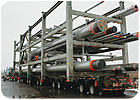
The pre-fireproofed beams are shipped to one of 10 module assembly yards in Edmonton where they are assembled into large erector set modules and filled with heavy pipes and equipment. The connecting ends of the beams are lathed and fireproofed in place at these yards before the modules are shipped off to various project sites by truck over the 300 miles of narrow road north to Ft. McMurray.
According to George Emery, training coordinator for the Local 222 Plasterers Apprenticeship School, in addition to hundreds of journeymen, there are more than 200 apprentices in Edmonton who are enrolled in courses that have been specifically designed to meet the need of industrial fireproofing in the oil and petrochemical industry. According to building trades sources, the manpower demand related to the construction in this area is expected to increase from its current level of 16,000 to a high of 28,000 construction workers by 2008.
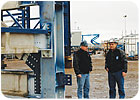
Brothers in the industrial fireproofing
business, one management the other labor (from right to left): Tony Wassill,
Lockerbie & Hole and Richard Wassill, Business Manager Local 222.
Photo by William E. Rogers
Photo by William E. Rogers
If you read this article, please circle number 330.
Sidebar: Resources:
Richard Wassill, Business Manager
George Emery, Training Coordinator
OPCMIA Local 222
www.local222.com
Jeff Granberg, President
Park Derochie Coatings Ltd.
www.parkderochie.com
Tony Wassill
Lockerbie & Hole
www.lockerbiehole.com
The Petroleum Communication Foundation
http://pcomm@pcf.ab.ca
Carboline Protective Coatings and Linings (Manufacturer of Pyrocrete 241)
www.carboline.com
Isolatek (manufacturer of Fendolite)
www.isolatek.com



